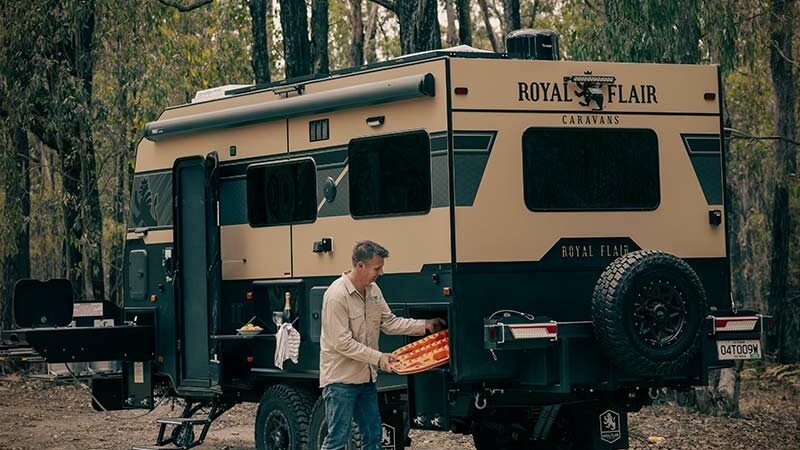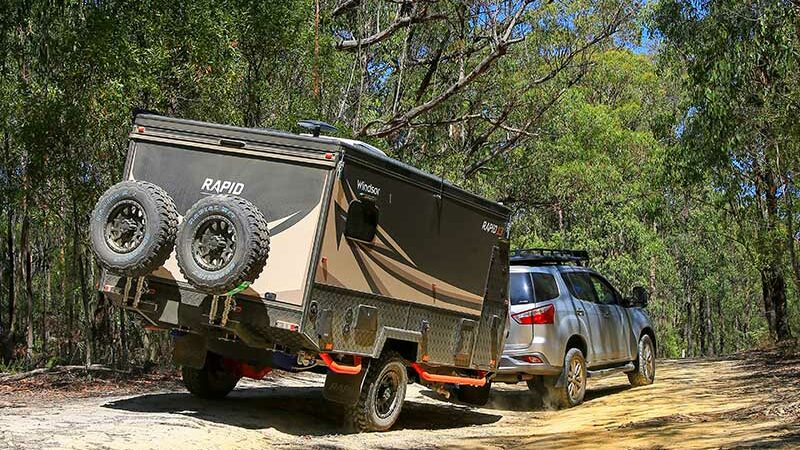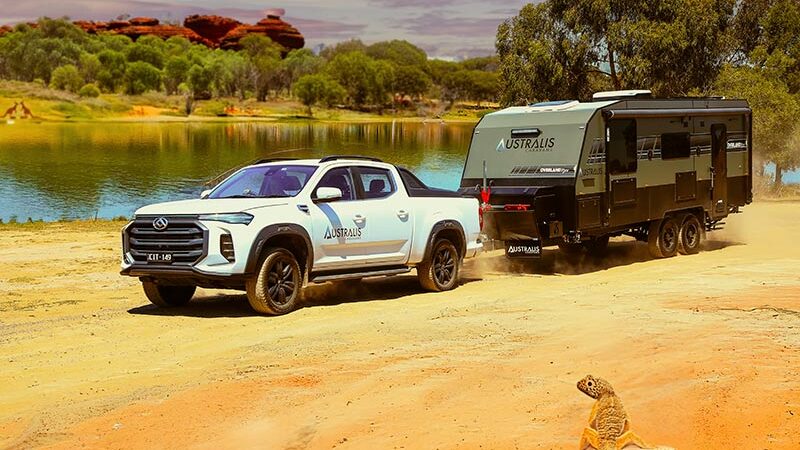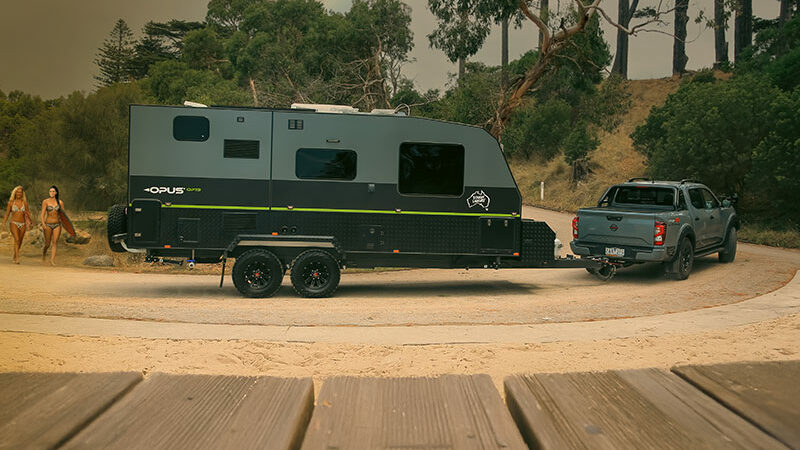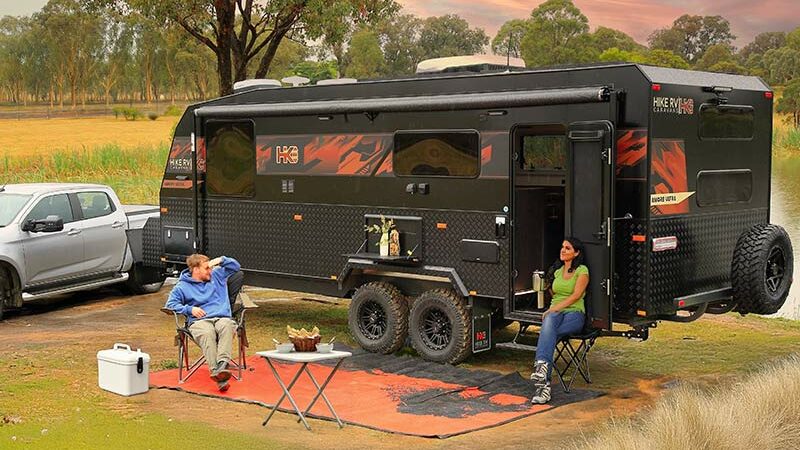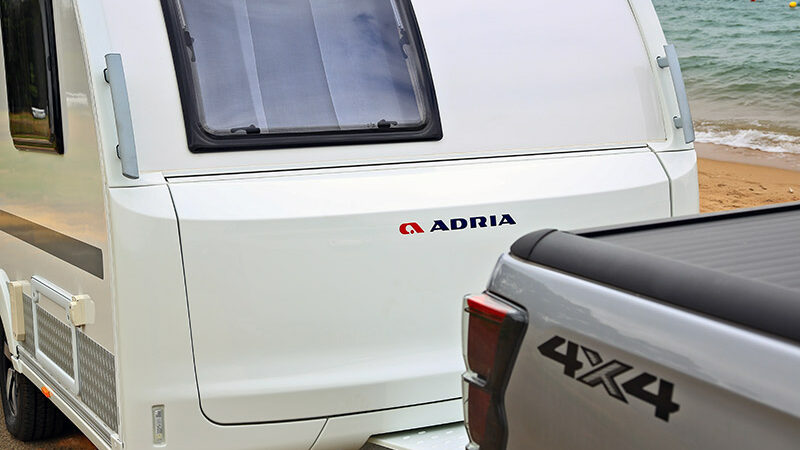Caravan Review: Harvok Dream Cruise
Looking for a van that’s a bit different? Something that stands out? I have my eye on Harvok at the moment. These monocoque vans are not only visually unique, they tow very well. At least, that was my experience when I hitched up the 19ft 6in Harvok Dream Cruise, a tandem-axle van with all the features and comforts for long-haul travels.
Harvok vans seem to be gaining traction in the Australian market, too. There’s a News South Wales dealership in Minchinbury, and a small Victorian dealership has now been established in Braeside.
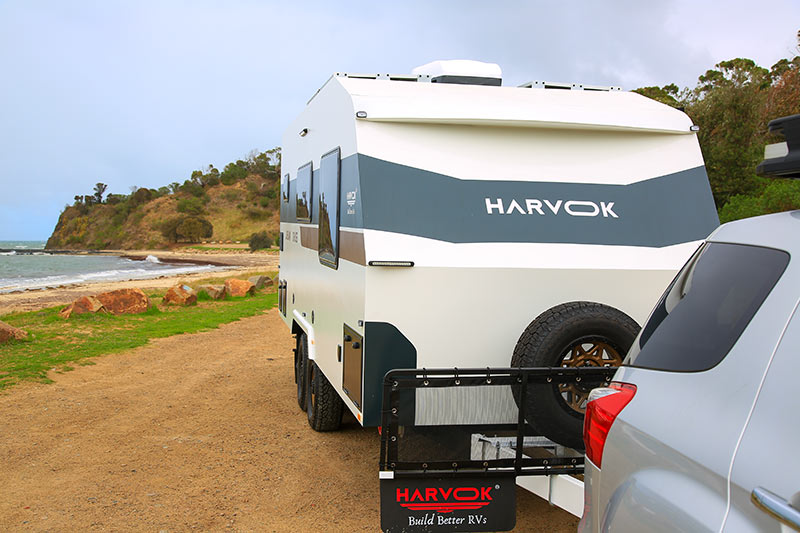 With the Dream Cruise on the back of my MU-X, I hauled it along the freeway towards the Mornington Peninsula, sitting comfortably on 100km/h. At no stage did the van twitch or feel otherwise unsettled. It was certainly one of the better-behaved vans I’d towed in recent times. There’s a reason for this. Read on…
With the Dream Cruise on the back of my MU-X, I hauled it along the freeway towards the Mornington Peninsula, sitting comfortably on 100km/h. At no stage did the van twitch or feel otherwise unsettled. It was certainly one of the better-behaved vans I’d towed in recent times. There’s a reason for this. Read on…
HARVOK CONSTRUCTION
As I mentioned, the Harvoks feature monocoque construction. Aluminium panels are fitted over an aluminium frame; however, each panel, including the roof, are robotically welded together, creating seams that to my eye are so precise that they appear more like folds.
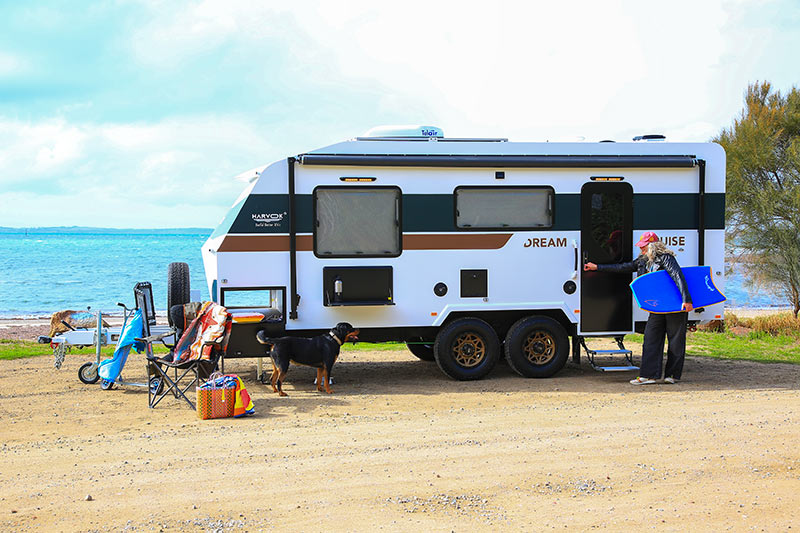 However, while it is a one-piece construction, a large section of the rear panel is fitted separately and sealed up with silicone. This is to allow the internal fittings, from the fridge to all furniture and cabinetry, to be brought inside for fitment. The silicone work is very neat and when painted with the automotive chip-resistant paint that’s used for the entire van, it’s barely noticeable.
However, while it is a one-piece construction, a large section of the rear panel is fitted separately and sealed up with silicone. This is to allow the internal fittings, from the fridge to all furniture and cabinetry, to be brought inside for fitment. The silicone work is very neat and when painted with the automotive chip-resistant paint that’s used for the entire van, it’s barely noticeable.
The body of the van is built atop an aluminium sub-frame that is bolted to the van’s 6in chassis, which is fabricated from steel with a tensile rating of 700 – it’s high-strength structural steel. However, because aluminium and steel aren’t ‘friends’ – aluminium will corrode steel over time – Harvok fits a special gasket between the body’s sub-frame and the chassis. The overall structural design, with the body bolted to the chassis in the way that it is, is intended to make the body and chassis ‘work’ as one.
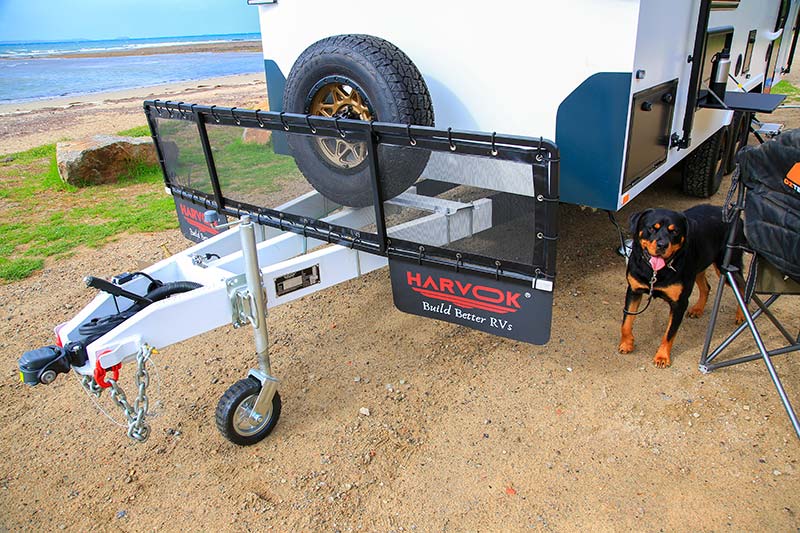 It rides on independent torsion bar suspension with 12in electric brakes and 16in alloy wheels, with a spare wheel mounted to the drawbar, behind a mesh stoneguard,
It rides on independent torsion bar suspension with 12in electric brakes and 16in alloy wheels, with a spare wheel mounted to the drawbar, behind a mesh stoneguard,
Underneath, you’ll find two 100L fresh water tanks as well as a 70L grey water tank. If I had one complaint, it would be that the grey water tank’s PVC outlet is unprotected, but that could be a DIY job – a pool noodle would do the trick.
The body of the van contains two ‘aerofoils’, one at the front and one at the rear. The idea, of course, is to improve the van’s aerodynamic efficiency and, in doing so, improve the way it handles under tow. I’m told that Harvok has conducted testing in regards to the efficacy of these aerofoils, too. In any event, I can only report on my experience towing it at highway speeds, and it really did pass with flying colours. While the van has a Tare weight of 2483kg, if you wanted to make full use of its payload capacity (ATM: 3500kg), you’d want a more muscular tow vehicle than my first-gen MU-X. That said, my car was fine for the job at hand, and hauled the Dream Cruise along brilliantly.
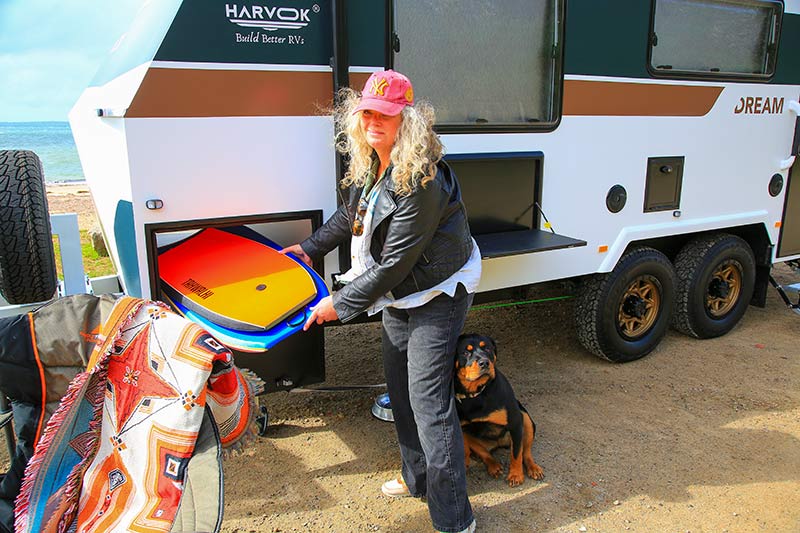 Externally, I didn’t feel as though the van was missing anything crucial. There’s a protected tap on the A-frame, a tunnel boot towards the front, a roll-out awning with anti-insect LED lights, a picnic table, and an entertainment locker with the relevant fittings to allow you to watch the footy outside.
Externally, I didn’t feel as though the van was missing anything crucial. There’s a protected tap on the A-frame, a tunnel boot towards the front, a roll-out awning with anti-insect LED lights, a picnic table, and an entertainment locker with the relevant fittings to allow you to watch the footy outside.
However, one small thing: inside the entertainment locker, Harvok has fitted an Anderson plug that sits loosely inside on its lead. I’m agnostic about it, but I did ask why the plug wasn’t mounted to the chassis. I was told that by having it in the entertainment locker, it’s in a sealed environment out of the weather, and it makes it almost impossible to forget to disconnect the portable solar panels before towing the van away. This thinking does make a certain amount of sense, I have to admit.
Other features include a rearview camera, offside hatch access to the toilet cassette and hot water service, a couple of nearside speakers, and a double-step leading up to the door.
Before I even stepped inside, I had two big takeaways about this van: the welds are figuratively seamless, and its performance under tow. In my eyes, this van was off to a good start. I don’t mind the white finish, either.
BREATH OF FRESH AIR
The layout incorporates a comfortable but not plush dinette upholstered in faux leather, with snap-up footrests on both ends. The kitchen sits opposite, filling out the nearside wall. In terms of cooking, the van is limited to an induction cooktop with two elements, and a microwave above the Dometic compressor fridge.
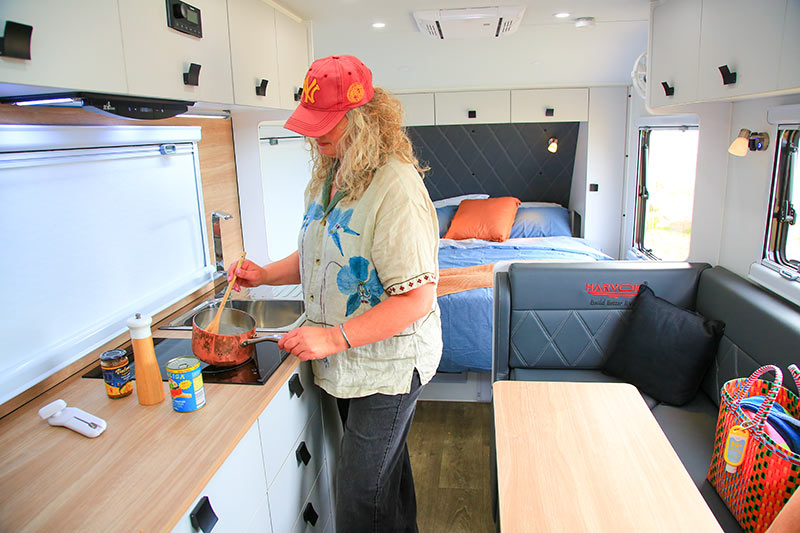 This is where we need to talk about the van’s power system. The Harvok’s monocoque construction is one point of difference, but so its off-grid power system. In a market that almost exclusively uses 12V power, Harvok employs a 48V electrical system comprised of a 5kWh 48V lithium battery. This roughly equals 104Ah; however, if this sounds low, it is crucial to realise the efficiency dividend offered by 48V over 12V. Every time voltage doubles, the amp draw halves, making a 48V lithium battery four times more efficient than a 12V battery. This is another one of Harvok’s key selling points
This is where we need to talk about the van’s power system. The Harvok’s monocoque construction is one point of difference, but so its off-grid power system. In a market that almost exclusively uses 12V power, Harvok employs a 48V electrical system comprised of a 5kWh 48V lithium battery. This roughly equals 104Ah; however, if this sounds low, it is crucial to realise the efficiency dividend offered by 48V over 12V. Every time voltage doubles, the amp draw halves, making a 48V lithium battery four times more efficient than a 12V battery. This is another one of Harvok’s key selling points
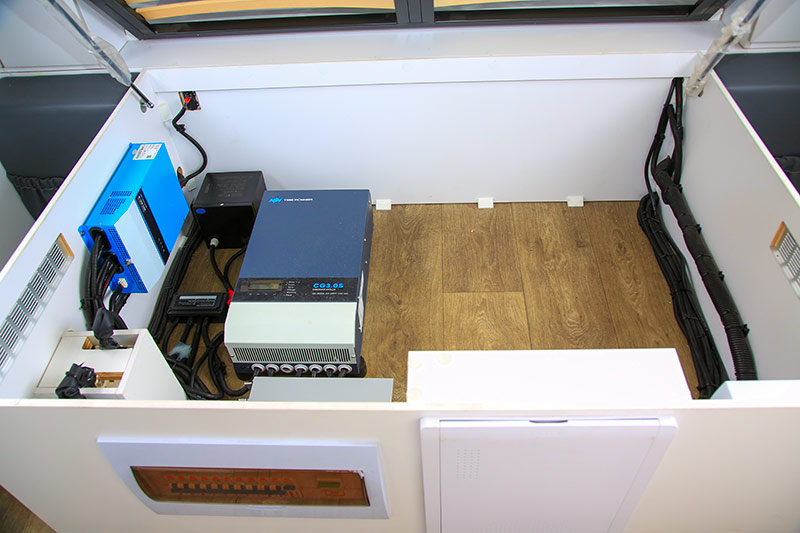 The system is linked to Harvok’s Smart Power Management System, and comes with a 3000W 48V inverter, allowing you to run the induction cooktop and compressor fridge off-grid, as well as the roof-mounted reverse-cycle air-conditioner. The system also includes 480W worth of solar on the roof and a 48V solar regulator.
The system is linked to Harvok’s Smart Power Management System, and comes with a 3000W 48V inverter, allowing you to run the induction cooktop and compressor fridge off-grid, as well as the roof-mounted reverse-cycle air-conditioner. The system also includes 480W worth of solar on the roof and a 48V solar regulator.
The power management system, etc., is mounted under the bed, though I did wonder if it could be sealed off with a ply housing of some kind, which would help you avoid accidental damage when making use of the rest of this storage space. Just a thought.
The rear bathroom runs the width of the van. It includes a top-loader washing machine, cassette toilet, and nearside shower, a large mirror, cupboards… it’s an attractive space. No complaints.
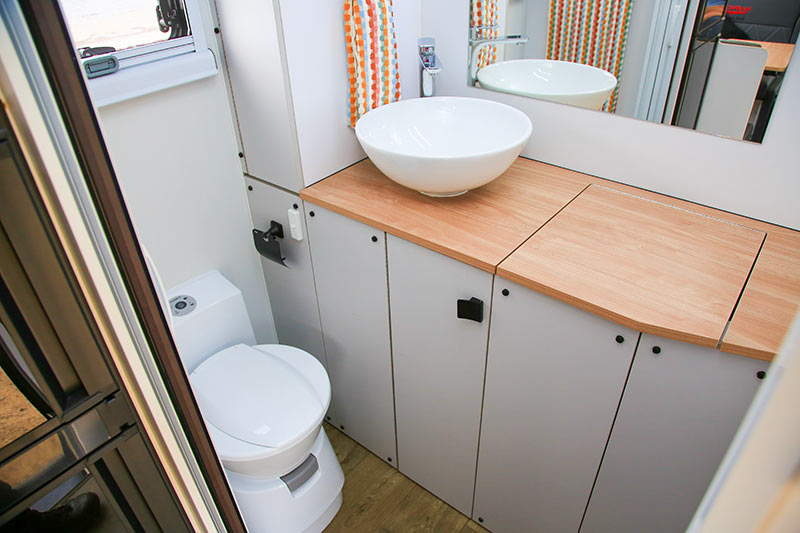 There are, however, two small things that I feel could be better presented. First, the microwave could use a surrounding fascia. It’s perfectly functional, but some trim of some description would finish off the microwave ‘cubby’ nicely. Second, I think the Fusion sound system would be better mounted elsewhere. It is currently mounted to the door of an overhead locker, which means you can see the wiring harness every time you open this locker.
There are, however, two small things that I feel could be better presented. First, the microwave could use a surrounding fascia. It’s perfectly functional, but some trim of some description would finish off the microwave ‘cubby’ nicely. Second, I think the Fusion sound system would be better mounted elsewhere. It is currently mounted to the door of an overhead locker, which means you can see the wiring harness every time you open this locker.
Neither of these are big issues that impede performance – they’re aesthetic things which, I’m told, the company plans to address.
That aside, the interior is breath of fresh air. It looks and feels different to what you might be used to, and it all comes together well. One other thing: the light switches can be positioned anywhere you like, or even taken outside with you. They are wireless, sending a signal to a receiver under the bed every time they’re pressed. Simply use some double-sided tape to permanently mount them in your preferred position. I liked the ‘automotive’ look of the water tank gauges, too.
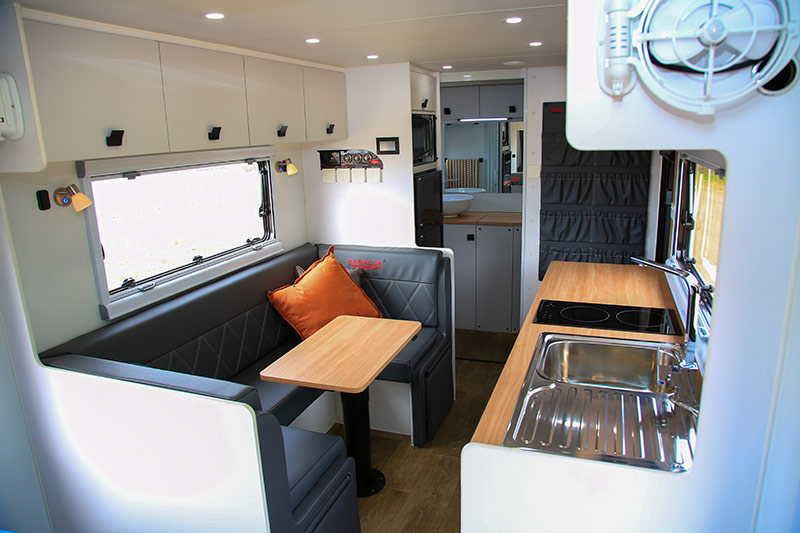 Being a gas-less caravan, I should point out that it doesn’t have a lower door vent – one less place for dust to get inside.
Being a gas-less caravan, I should point out that it doesn’t have a lower door vent – one less place for dust to get inside.
GORV’S VERDICT
The 19ft 6in Harvok Dream Cruise has a lot going for it, from its monocoque construction to its 48V electrical system. I also appreciate the fact that it just looks different. In a market filled with homogenous caravans made of timber and composite aluminium cladding, the Harvok stands out as unique and worth a good, long look. Oh, and did I mention that it is a dream to tow?
THE SCORE
FIT AND FINISH – 
LAYOUT – 
INNOVATION – 
HITS & MISSES
HITS & MISSES
- Monocoque construction and the finish of the welds
- The 48V electrical system
- The interior decor/layout is a breath of fresh air
- Very well behaved under tow – one of the best towing vans I’ve reviewed in recent times
- I think the sound system needs to be repositioned
- I’d add a fascia/trim around the microwave
- Can the equipment under the bed be housed off somehow?
COMPLETE SPECS
Overall length: 8.5m
External body length: 6.2m
External width: 2.2m (excluding awning)
Travel height: 3.1m (including air-con)
Internal height: 2m
Tare: 2483kg
ATM: 3500kg
Unladen ball weight: 159kg
Frame: Aluminium
Cladding: Robotically welded one-piece aluminium panels
Coupling: DO35
Chassis: 6in hot-dipped galvanised
Suspension: Independent torsion suspension
Brakes: 12in electric
Wheels: 16in alloy
Fresh water: 2x100L
Grey water: 1x70L
Shower: Yes
Awning: Manual roll-out
Battery: 5kWh 48V lithium with Harvok Smart Power Management System and 3000W 48V inverter
Solar: 480W with 48V regulator
Air-conditioner: Roof-mounted reverse-cycle
Gas: No
Bike rack: No
Sway control: No
Cooking: Two-element induction
Refrigeration: Dometic compressor
Microwave: Yes
Shower: Hand-held
Heating: Reverse-cycle AC only
Toilet: Cassette
Washing machine: Top-loader
Lighting: LED
Entertainment: Fusion sound system with internal and external speakers; bracket for TV provided
RRP: $79,990
The post Caravan Review: Harvok Dream Cruise appeared first on GoRV.
Source: https://www.gorv.com.au/caravan-review-harvok-dream-cruise/


